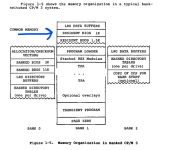Can someone smarter than I, please clarify the CCP, BDOS, BIOS disk vs RAM layout, for both CP/M 2.2 and 3.0? So here is what I always understood (CP/M 2.2 Manual section 6, CP/M Alterations):
CP/M 2.2
CPM.SYS contains CCP+BDOS+BIOS
DISK drive 0, side 0, track 0, sector 1: bootloader
drive 0, side 0, track 0, sector 2: start CCP+BDOS+BIOS end
RAM (booted): lower-end CCP, BDOS+BIOS higher-end
CP/M 3.0
CPM3.SYS contains BDOS+BIOS
CCP.COM separate file
DISK drive 0, side 0, track 0, sector 1: bootloader
drive 0, side 0, track 0, sector 2: start BDOS+BIOS end, next file CCP.COM
RAM (booted): lower-end CCP, BDOS+BIOS higher-end
CP/M 2.2 boots by loading:
CCP follows from disk to RAM starting at CBASE to FBASE-1
BDOS follows from disk to RAM starting at FBASE to FBASE+3.5K
BIOS from the start of the disk to RAM starting at FBASE+3.5K+1 to HIGH
CP/M 3.0 unbanked
it is similar to CP/M 2.2 but with different locations/size limits.
CP/M 3.0 banked
BNK0 is loaded with resident CCP, BDOS+BIOS
BNK2 is loaded with banked portion of CCP, BDOS+BIOS
Clarification Questions:
1) CP/M boot process reads the sequential disk layout of CCP+BDOS+BIOS and reorders them to (CCP, BDOS, BIOS) in high memory, right?
2) The bootstrap, usually in ROM that loads bootloader d0, h0, t0, sector1
3) bootloader loads CCP+BDOS+BIOS from disk, right?
CP/M eligant memory layout easily allows the TPA to overlay CCP and then reload CCP later.
I have recently read that the disk layout of the boot track is BIOS+BDOS+CCP which I'm doubting its correctness, hence this discussion. Thanks.
CP/M 2.2
CPM.SYS contains CCP+BDOS+BIOS
DISK drive 0, side 0, track 0, sector 1: bootloader
drive 0, side 0, track 0, sector 2: start CCP+BDOS+BIOS end
RAM (booted): lower-end CCP, BDOS+BIOS higher-end
CP/M 3.0
CPM3.SYS contains BDOS+BIOS
CCP.COM separate file
DISK drive 0, side 0, track 0, sector 1: bootloader
drive 0, side 0, track 0, sector 2: start BDOS+BIOS end, next file CCP.COM
RAM (booted): lower-end CCP, BDOS+BIOS higher-end
CP/M 2.2 boots by loading:
CCP follows from disk to RAM starting at CBASE to FBASE-1
BDOS follows from disk to RAM starting at FBASE to FBASE+3.5K
BIOS from the start of the disk to RAM starting at FBASE+3.5K+1 to HIGH
CP/M 3.0 unbanked
it is similar to CP/M 2.2 but with different locations/size limits.
CP/M 3.0 banked
BNK0 is loaded with resident CCP, BDOS+BIOS
BNK2 is loaded with banked portion of CCP, BDOS+BIOS
Clarification Questions:
1) CP/M boot process reads the sequential disk layout of CCP+BDOS+BIOS and reorders them to (CCP, BDOS, BIOS) in high memory, right?
2) The bootstrap, usually in ROM that loads bootloader d0, h0, t0, sector1
3) bootloader loads CCP+BDOS+BIOS from disk, right?
CP/M eligant memory layout easily allows the TPA to overlay CCP and then reload CCP later.
I have recently read that the disk layout of the boot track is BIOS+BDOS+CCP which I'm doubting its correctness, hence this discussion. Thanks.

